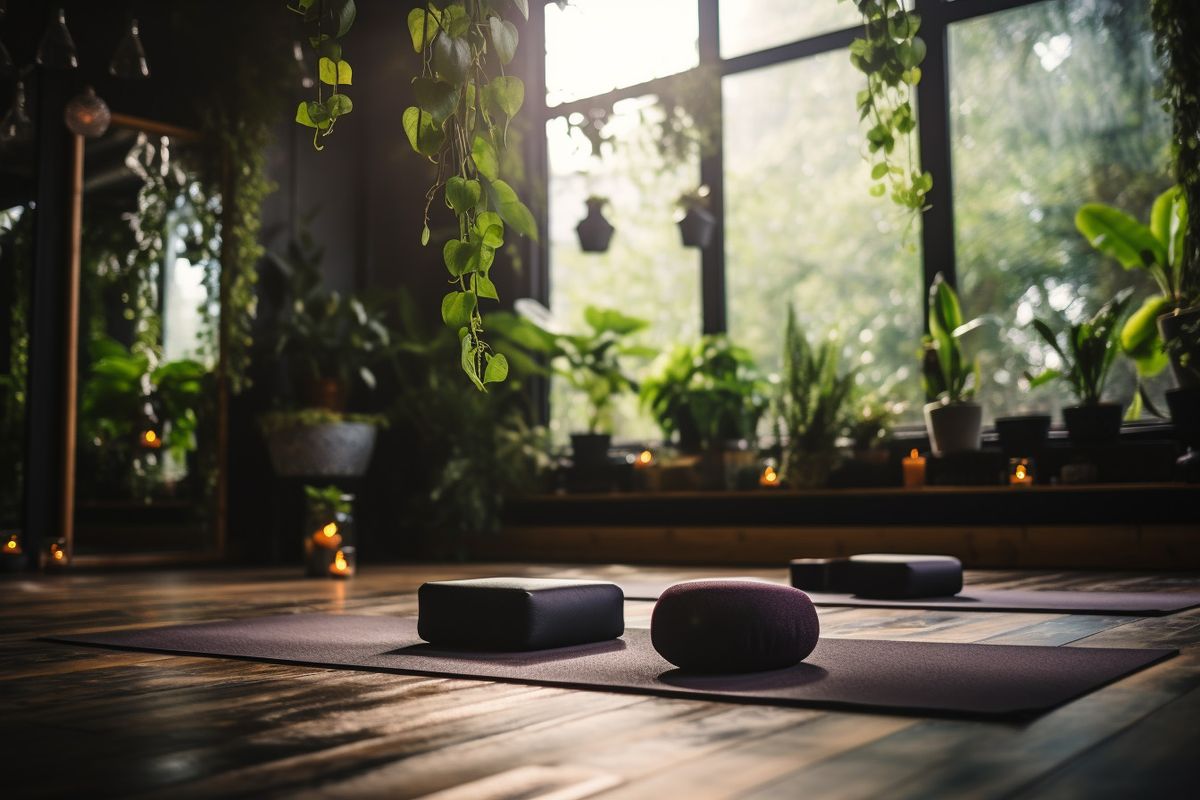Why Choose Supported Wide-Angle Forward Bend (Salamba Upavista Konasana)?
Unlike more strenuous poses, the supported version of Wide-Angle Forward Bend serves as an excellent way to rejuvenate. It is often recommended towards the end of yoga sessions as it helps in relaxing the nervous system, making you feel refreshed and revitalized.

Introduction: Embrace the Support in Your Forward Bend
Discover the nuanced practice of the Supported Wide-Angle Forward Bend, a transformative yoga pose that offers both physical and mental benefits.
Historical Background: Understanding the Origins of Salamba Upavista Konasana
The pose commonly referred to as the Supported Wide-Angle Forward Bend has its roots in the ancient Sanskrit term "Salamba Upavista Konasana." This is pronounced Sah-lum-bah Oo-pah-vee-stah Koe-nah-sah-nah
Salamba: The Essence of Support
The term "Salamba" is a critical component of Salamba Upavista Konasana. In Sanskrit, "Sa" means "with," and "Alamba" translates to "support." Together, they denote a version of Upavista Konasana with added support, often using props like bolsters, blocks, or cushions. This element of support makes the pose more accessible and enhances its restorative properties.
Upavistha: A Seated Position
The "Upavistha" in Salamba Upavista Konasana refers to the seated nature of the pose. It serves to ground the practitioner both physically and emotionally, acting as a foundation for the entire posture.
Kona: Creating Angles
In Sanskrit, "Kona" signifies the angle created by the legs as they extend outward from the hips. The angle can vary from person to person but aims to form a V-shape. This is a key aspect of the Salamba Upavista Konasana, as it stretches the inner thighs and hamstrings.
Asana: The Posture
"Asana," meaning "pose" or "posture," completes the term Salamba Upavista Konasana. It underlines the physical alignment and form that the pose demands, anchoring the practice in the traditions of yoga.
Differences: Unsupported vs. Supported Wide-Angle Forward Bend
The Basic Structure: A Common Foundation
Both the unsupported and supported versions of Wide-Angle Forward Bend share a common foundation. The core structure involves sitting with your legs extended wide apart and folding forward at the hips.
Support Factor: Comfort and Accessibility
The most obvious difference is the use of props in the supported version. These props, such as bolsters, cushions, or blocks, offer extra comfort and enable a deeper forward bend.
This makes the pose more accessible for beginners, those with physical limitations, or anyone looking to focus more on relaxation and less on muscular engagement.
Intensity Level: From Passive to Active
In the unsupported version, you engage your core and back muscles more intensely to maintain the posture. It demands a greater level of muscle control and balance.
The supported version, however, allows for a more passive experience. Here, the props support your weight, enabling your muscles to relax, which is often the focus in practices like Restorative or Yin Yoga.
Duration: How Long You Stay Matters
Given the less intense nature of the supported version, it’s generally easier to hold for extended periods.
This is advantageous for those looking to benefit from the meditative aspects of the pose or to indulge in a deeper stretch facilitated by longer duration.
Alignment and Safety: Reducing Risk of Injury
The use of props in the supported version provides a safety net for those who are prone to overstretching or have certain back issues. By offering a structured way to perform the asana, props help ensure proper alignment and reduce the risk of injury.
Physical Benefits: Why Choose the Supported Version
Gentle on the Lower Back: A Haven for Spinal Health
One of the foremost advantages of opting for the supported variation of Wide-Angle Forward Bend is the reduced stress on the lower back.
The props act as a cushion, distributing your body weight evenly and relieving the lumbar spine from undue pressure. This makes the pose particularly beneficial for those recovering from back injuries or dealing with chronic lower back pain.
Enhanced Flexibility: Taking Your Stretch to the Next Level
While both versions of the pose aim to improve flexibility, the supported version allows you to go deeper into the stretch without exerting your muscles.
The props enable a more relaxed approach to the asana, providing you the leeway to explore your flexibility limits safely and comfortably. This makes it particularly effective for opening up the hamstrings and inner thighs.
Stress Reduction and Mental Clarity: The Mind-Body Connection
The supported version, with its less intense muscle engagement, naturally lends itself to relaxation. The props provide a level of comfort that encourages deeper, slower breathing, leading to a calmer state of mind.
The mental clarity that arises from practicing this pose can be a boon in today’s fast-paced, stressful environments.
Step-By-Step Instructions: Mastering Salamba Upavista Konasana
Step 1: Prepare Your Space
Place a yoga mat on a flat surface. Place a bolster, cushion, or folded blanket at one end of the mat where you'll be reclining forward.
Step 2: Take a Seated Position
Sit on the mat, with your legs extended in a V-shape. Your back should be straight and hands resting on the floor for support. Position the bolster in front of you, so it's touching your lower abdomen.
Step 3: Inhale Deeply
Take a deep inhalation, expanding your chest and preparing your body to move into the pose.
Step 4: Recline Forward
As you exhale, start to recline forward from your hips, hugging or draping your upper body over the bolster. Allow your arms to rest naturally, either stretched out in front of you or loosely by your sides.
Step 5: Rest and Breathe
Rest your forehead on the bolster or turn your head to one side. Close your eyes and breathe deeply, allowing yourself to relax into the support of the bolster.
Step 6: Maintain the Pose
Hold Salamba Upavista Konasana for anywhere from 1 to 5 minutes, depending on your comfort level. Use this time to breathe deeply and let go of any tension in your body.
Step 7: Exit the Pose
To come out of the pose, gently lift your torso off the bolster, using your hands for support. Sit up slowly, drawing your knees together, and give yourself a few moments to absorb the benefits of the pose before moving on to your next asana.
Step 8: Reflect
Take a moment to reflect on the sensations in your body and your emotional state. Acknowledge the peace and relaxation you've achieved, setting a positive tone for the rest of your practice.
Common Mistakes to Avoid: Optimize Your Practice
Overstretching the Legs
While it's beneficial to stretch the inner thighs and hamstrings, pushing too hard can lead to strain or injury. Listen to your body, and don't force the legs into a wider angle than is comfortable.
Rushing Through the Pose: Take Your Time
This is not a race. Each body is different and requires its own time to settle into a pose. Rushing through the steps or holding the pose for too short a time lessens the restorative and flexibility-enhancing benefits that this asana offers.
Ignoring Discomfort
If you feel any pain while in the pose, it’s a sign that something is not right. It could be your alignment, the prop's placement, or perhaps this pose isn't suitable for you at this time. Never ignore these signals from your body.
Complementary Supported Poses: Expand Your Routine
Supported Child's Pose (Salamba Balasana)
This pose is excellent for stretching and relaxing the back, making it a perfect follow-up or precursor to the Supported Wide-Angle Forward Bend. It allows your spine to return to a neutral position and helps to ease any tension built up in the back muscles.
Supported Bridge Pose (Salamba Setu Bandha Sarvangasana)
Supported Bridge Pose provides a gentle inversion, encouraging blood flow back to the heart and head. This balances out the forward folding nature of the Wide-Angle Forward Bend and offers a different type of stretch and relaxation for the spine.
Supported Pigeon Pose (Salamba Eka Pada Rajakapotasana)
This pose deeply opens the hip flexors and external rotators. It complements the inner thigh and hamstring stretch that you get from the Wide-Angle Forward Bend, making for a well-rounded hip and leg stretching routine.
Supported Savasana (Salamba Savasana)
As the ultimate restorative pose, Salamba Savasana allows the body to fully absorb the benefits of your practice. It is an excellent way to conclude any yoga session, especially one that includes deep stretches like the Wide-Angle Forward Bend.
Supported Fish Pose (Salamba Matsyasana)
This pose opens up the chest and throat area, counteracting the forward-bending nature of the Wide-Angle Forward Bend. It helps in balancing the spine and encourages deep breathing, making it a valuable addition to your practice.
Conclusion: Integrating Supported Wide-Angle Forward Bend into Your Practice
Supported Wide-Angle Forward Bend is a wonderful adaptation that allows for both deep stretching and relaxation. Incorporating this pose into your regular yoga practice can significantly benefit your flexibility, mental clarity, and overall well-being.



Comments ()